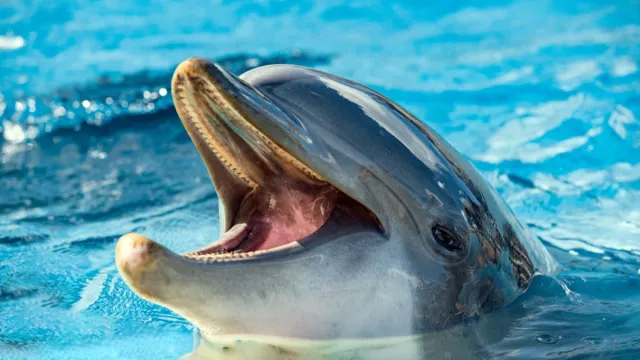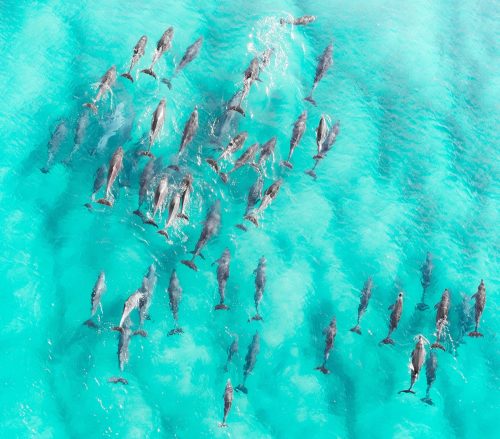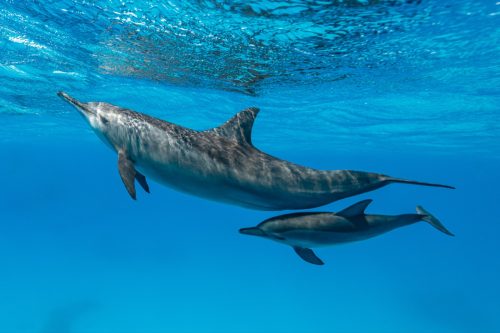Are Dolphins Dangerous? 17 Facts That Suggest They Are

Dolphins have an impressive reputation. Not only are they incredibly intelligent, but they also tend to interact with humans on a regular basis. But are dolphins dangerous? Unfortunately, these wild animals have been responsible for more than a few vicious and fatal attacks. Want to know more? Read on for all the ways dolphins are more menacing than you may have thought.
READ THIS NEXT: 75 Weird Animal Facts Everyone Should Know.
17 Reasons Dolphins Are More Dangerous Than You Ever Thought
Just because dolphins have a perpetual grin and an overall friendly demeanor doesn’t mean they’re safe. The risks these animals pose to their human counterparts have been well documented, including a 2019 incident where a little girl was dragged underwater and bitten by two captive dolphins during an ocean excursion.
Fortunately, the 10-year-old was able to escape with just a few scratches—though the experience likely left a few mental scars that won’t fade anytime soon. Below, we’ve documented a few more facts that might make you think twice before you sign up to swim with dolphins.
1. Dolphins bite.

Dolphins have sharp teeth that they usually use to rip apart their prey. Bottlenose dolphins, for example, have between 80 and 100 teeth that they use to grab, grip, and secure their prey.
However, the creatures can (and do!) bite humans on occasion. Because of the potential danger, officials at the Commerce Department’s National Marine Fisheries Service have even released fliers with warnings that “dozens of bites have been reported and people have been pulled underwater” by the animals.
In fact, as recently as 2012, an 8-year-old girl was infamously bitten by one of the animals while feeding dolphins at SeaWorld.
2. And attack.

Dolphins do more than just bite their victims during an attack. When Valerie Ryan was attacked by a dolphin, the animal “plowed into [her] with [its] snout. It was very powerful and painful, and the speed was amazing,” she said.
The incident left the woman with six spinal fractures, three broken ribs, and a damaged lung, as well as post-traumatic stress.
3. They’re always developing new ways to hunt and kill their prey.

When dolphins are hungry, they turn into calculating predators who are capable of developing unusual methods to trap their prey. For instance, dolphins that live in the shallow waters of Florida have been observed using their tails to kick up mud in a circular formation in order to trap fish inside, while dolphins who live in Shark Bay, Australia, have been seen using sponges as tools to dig up prey from the seafloor.
What’s more, dolphins are able to communicate these tactics with other dolphins, which means they’re always improving their skills. According to the Smithsonian, “dolphins learn different tricks for catching food from one another in a kind of cultural transmission.”
READ THIS NEXT: 32 Rare Animals So Unusual, You Might Not Know They Even Exist.
4. They sometimes hunt in groups of 1,000 or more.

Add this to the list of terrifying sights we never want to see: Hundreds of dolphins hunting for food at the same time.
The Smithsonian also reports that bottlenose dolphins sometimes hunt in groups of more than 1,000 members, although they typically stick to pods of around 10 to 15 individuals, according to National Geographic.
5. They frequently torture their food before eating it.

Octopuses have a few deadly defense mechanisms at their disposal, which is why dolphins need to be careful when making these creatures into a meal. With that in mind, dolphins “beat up” octopuses by viciously and relentlessly tossing them around in order to break them into smaller pieces before consuming them. Eek!
6. They murder other animals just for fun.

Sure, it’s a vicious world out there in the animal kingdom, but dolphins don’t only kill other creatures to survive. Sometimes, they have mysteriously murderous motivations. According to the New York Times, dolphins “are killing fellow mammals in droves, wielding their beaks as clubs and slashing away with rows of sharp teeth.”
Apparently, the underwater beasts “have been found to bludgeon porpoises to death by the hundreds.” And while “most animal killers … eat their prey, dolphins seem to have murderous urges unrelated to the need for food.”
7. They even kill each other’s babies.

While it may be hard to accept, scientists have discovered that adult dolphins sometimes kill the babies of other dolphins. According to a 2002 study published in the Journal of Wildlife Diseases, nine bottlenose dolphin calves were found in Virginia in 1996 and 1997 that had “died of severe blunt-force trauma.”
The young animals had apparently suffered “multiple rib fractures, lung lacerations, and soft tissue contusions,” and “one had a bite wound across the left mandible that exhibited deep punctures consistent with the tooth placement in an adult bottlenose dolphin.”
8. Male dolphins attack female dolphins.

Along with attacking other creatures, dolphins also go after their own kind. One 1992 study published by the National Academy of Sciences found that when male dolphins want to mate, they not only chase females, but they also show violent physical aggression toward them, which includes “hitting with the tail, head-jerks, charging, biting, or slamming bodily into the female.”
9. They’re a lot bigger than you probably thought.

When you picture a dolphin, you probably imagine an animal that’s about the same height as a grown man. But it turns out, these creatures are a lot bigger.
According to National Geographic, the common bottlenose dolphin grows anywhere from 10 to 14 feet, and weighs around 1,100 pounds!
READ THIS NEXT: 23 Dog Facts That Will Make You Even More Amazed by Your Best Friend.
10. They’re dangerously fast.

If you ever find yourself on a dolphin’s bad side, don’t put any money on your ability to outswim it. Thanks to their streamlined shape, which allows them to glide through the water, and their powerful tails, which propel them forward, dolphins have been observed traveling up to 20 miles per hour.
To put that in perspective, Olympic swimmer Michael Phelps’ top speed falls just short of six miles per hour, according to CBS Sports.
11. They can launch themselves out of the water.

Dolphins’ impressive speed is one of the ways they’re able to work up enough power to launch themselves out of the water. While it’s not an unusual sight to spot the creatures leaping over waves, bottlenose dolphins are actually capable of launching themselves up about 16 feet into the air, reports National Geographic.
In some cases, this ability has even led to scary situations in which dolphins have jumped onto boats—a fear you never knew you needed to have until now!
12. They can dive deeper than any human.

There’s no hiding from these seasoned travelers! Dolphins aren’t only capable of launching themselves out of the water, they can also dive incredibly well—meaning there are approximately zero ways you can escape one if you find yourself under attack.
The skillful swimmers have been known to dive as deep as 990 feet under the ocean’s surface. For comparison, the deepest world record no-limit free-dive by a human was 702 feet.
13. They’re smart enough to be used by the U.S. Navy.

Dolphins are so clever, they’re even used by the U.S. Navy. According to National Geographic, since the 1960s, the military has trained bottlenose dolphins “to find and retrieve equipment lost at sea and to identify intruders swimming into restricted areas.” You certainly wouldn’t want to be an enemy who finds themselves face to face with a military-trained dolphin.
14. They’ve got toxic friends.

While dolphins may be smart, you can’t always assume that they’re, well, sober. That’s because the animals are known to ingest some toxic substances. According to BBC One’s Dolphins—Spy in the Pod, “Bottlenose dolphins play with toxic pufferfish that secrete a neurotoxin that in high doses can kill but in small doses seemingly have a narcotic effect.”
The Daily Mail reports that in the BBC footage, “dolphins were filmed gently playing with the puffer, passing it between each other for 20 to 30 minutes at a time, unlike the fish they had caught as prey which were swiftly torn apart.” The animals were then “seen floating just underneath the water’s surface, apparently mesmerized by their own reflections.”
15. They know when they’re taunting us.

In a piece called “Dolphins Are Scarier Than Sharks” for HuffPost, marine scientist and longtime surfer Apryl DeLancey wrote about a frightening experience she had with a dolphin at Manhattan Beach in California.
While DeLancey was surfing, a dolphin started circling her and the surfer next to her. “The circles got smaller and smaller until it finally purposely bumped the back of my board and then jumped over me,” she recalled. “After the jump, the dolphin went back to circling us and eventually gave up and took off. It seemed to be either taunting us or wanted us to interact with it.”
DeLancey wrote that she’s had other dolphins jump over her board, too. She says sharks, on the other hand, have always minded their business and left her alone.
READ THIS NEXT: 29 Amazing Facts You Never Knew About Your Cat.
16. Humans’ “misconceptions” about dolphins could be deadly.

“People see marine mammals differently, particularly dolphins,” Trevor R. Spradlin, a federal dolphin expert, told the Times.
“There’s this misconception that they’re friendly, that they’re Flipper, that they want to play with people,” he said.
Obviously, you’ll want to treat any dolphin you encounter like the enormous, 1,100-pound wild animal that it is.
17. Dolphin attacks can be fatal.

Ultimately, dolphins are seriously scary because they can seriously kill you. Nat Geo Wild describes a 1994 case in which two men in São Paulo, Brazil, were rammed by a dolphin. Sadly, one man passed away due to internal injuries sustained during the incident.
FAQ
What is the difference between dolphins, porpoises, and whales?
Dolphins, porpoises, and whales are all part of the same classification, though the group is typically divided into two suborders: toothed whales and baleen whales. Both dolphins and porpoises fall into the first category while blue whales, humpback whales, and fin whales belong to the latter.
So, what does that mean? Toothed whales have, well, teeth—made of enamel. But baleen whales have bristly baleen plates, used to collect krill, plankton, and small fish from the sea. As a reminder, baleen is made of keratin (the same material found in hair and fingernails).
How many types of dolphins are there?
The dolphin family contains both oceanic and river dolphins. Orcas, or killer whales, actually account for the largest species of the group. To date, scientists have identified 49 dolphin and porpoise species that have been grouped into six separate families.
Are dolphin attacks more dangerous than shark attacks?
While sharks are responsible for more annual attacks on humans than dolphins, there are certainly reasons to believe that dolphin attacks may be more dangerous in the long run. Even though both events are extremely rare, dolphins have been known to attack people as a means of amusing themselves—not because they feel threatened. Meanwhile, the majority of shark attacks can be attributed to poor vision, as they often confuse humans with seals and other forms of natural prey.
Wrapping Up
That’s it for our list on just how dangerous dolphins can be, but be sure to check back with us soon for even more trivia! You can also sign up for our newsletter so you don’t miss out.
- Source: https://www.fisheries.noaa.gov/national/marine-life-viewing-guidelines/protect-wild-dolphins-admire-them-distance
- Source: https://ocean.si.edu/ocean-life/marine-mammals/bottlenose-dolphin-pod
- Source: https://pubmed.ncbi.nlm.nih.gov/12238367/
- Source: https://www.ncbi.nlm.nih.gov/pmc/articles/PMC48370/
- Source: https://www.humanesociety.org/animals/dolphins
- Source: https://www.nps.gov/redw/learn/nature/toothed-vs-baleen-whales.htm
- Source: https://www.science.org/content/article/video-shows-why-sharks-often-mistake-humans-prey